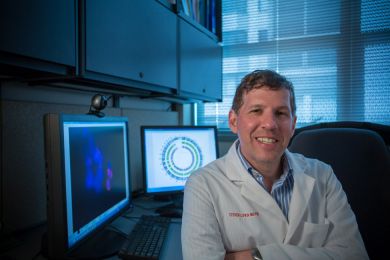Better mouse model enables colon cancer research
Every day, it seems, someone in some lab is “curing cancer.” Well, it’s easy to kill cancer cells in a lab, but in a human, it’s a lot more complicated, which is why nearly all cancer drugs fail clinical trials.
Taking steps to bridge this divide, engineers at Cornell and clinicians at Weill Cornell Medical College have created a comprehensive mouse model of exactly how colorectal tumors behave in real life - not just in a petri dish.
“Maybe the fact that it’s so hard to kill cancer cells in humans has something to do with where they grow,” said Xiling Shen, assistant professor of electrical and computer engineering and field member of biomedical engineering, co-lead author on a study in Nature Biotechnology published May 25. “Cancer cells will behave differently when interacting with their environment, as opposed to being grown in an artificial environment.”
The research team’s breakthrough, led by Shen and Steven Lipkin, M.D., associate professor of genetic medicine at Weill Cornell, was to engineer a way to seed and grow human colon cancer cells in a mouse intestine and colon, mimicking their correct environment.
In this improved mouse model, the human cancer cells can spread to other organs like the liver and lung, following the normal anatomic route of human metastasis. Upon injection into mouse embryos, the engineered human cells migrate to the thymus and the gut, to allow the immune system of the host mice to recognize these human cells as their own, rather than rejecting them.
The significance of this engineering feat is multifaceted. The model allows pharmaceutical companies to look for effective cancer therapies. What’s more, it allows scientists to study the colon cancer environment and metastasis, and perform experiments that are not feasible with human patients.
In previous live-animal cancer studies, only mice with artificially crippled immune systems could be used to test how human cancer forms. That’s because the immune systems of healthy mice would otherwise kill the foreign human cells, not allowing the cancer to play out: primary tumor growth, metastasis and eventually, death.
The Cornell model uses healthy mice, circumventing that normal cell rejection process. The engineers manipulate chemical signals called chemokines, which naturally regulate how cells move in the body, to herd injected human cells through the thymus, where the immune system of the body learns to tolerate its own cells. By using chemokines like a GPS for the human cells to navigate the mouse body, the engineers can produce healthy mice that tolerate colorectal cancer cells, and follow the normal trajectory of cancer in a human.
“A better mouse model recapitulates the real physiology of the tumor,” Shen said. “But also, we found that the tumor environment, which includes the immune system, is very important for tumor behavior. If you ignore the environment, you’re not really capturing what the tumor cell is doing.”
The researchers are continuing to study other aspects of the colon cancer cell microenvironment. In a separately published paper in Nature Communications, they identified a molecule called a microRNA that, when expressed, promotes metastasis for stage II colon cancer patients.
With the Nature Biotechnology study, the researchers have underscored the important role that the immune system plays in preventing colon cancer metastasis, and more studies are needed to figure out exactly how. According to Lipkin, the research opens up doors to additional studies on how immunotherapies could be applied to colon cancer.
“This is an exciting development, and one that we hope will finally impact the development of therapeutic options for colorectal cancer patients,” Lipkin said.
The paper is titled “Comprehensive models of human primary and metastatic colorectal tumors in immunodeficient and immunocompetent mice by chemokine targeting,” with first author Joyce Chen, a graduate student in Shen’s lab. The work was supported by the National Science Foundation and the National Institutes of Health.



